We came to Oslo, Norway from Copenhagen (my first blog post from this trip appears here). It was supposed to be by train, but the Swedish National Railroads were repairing some tracks and due to surprising disorganization, we got stuck sitting in the Gothenberg central station for 4 hours waiting for a bus to run us up to Trollhatten where we could get back on a train. So the travel day was very long, but we were greeted by our hosts Audun and Tine, and have had a very nice visit here.
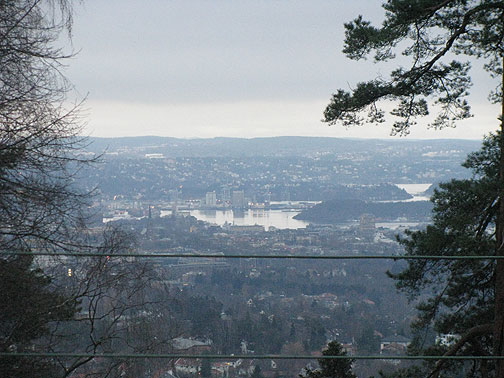
A gray wintery city, Oslo only has daylight from about 8 am to 4 pm these days.
On Saturday, I gave a Nowtopia talk as part of a “Social Change, Not Climate Change” talk at a local social center called Humla. About 20 people showed up, and I gave a shortened version of my usual talk since the point here is to fit it in a larger discussion about Climate politics. I shared billing with a couple of Swedes who came over from Stockholm to talk about their fascinating group called Planka.nu, which means something like “Crash it now!”, referring to their program of advocating free transit by jumping turnstiles and gates and not paying. The organization enrolls dues-paying members and if they get caught by the transit police without a paid fare, Planka pays their ticket. It’s a kind of insurance for free riders, and has its roots in both the anarcho-syndicalist youth movement (that has been around since the 1930s, and is connected to a national anarcho-syndicalist labor federation) and an autonomous Marxist think tank. I’ll write more about this later, probably in a full length report at Streetsblog after I interview them this week.
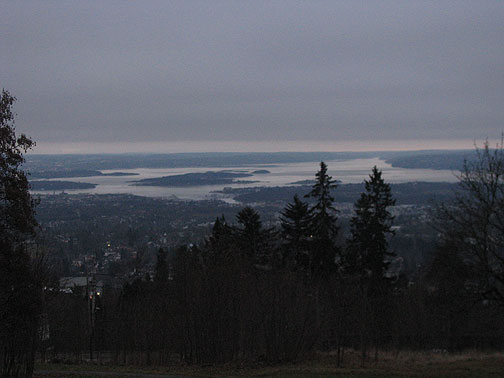
Lots of water surrounding Oslo.
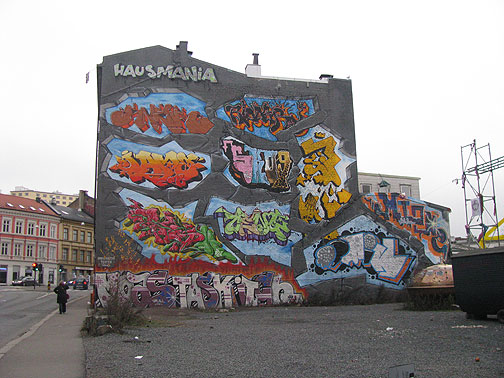
This is Humla, where our presentations were made on Saturday, Nov. 28.
Here in Norway, there’s not a lot of excitement about social activism or resistance, although I was invited to speak here in part to promote both. The Saturday presentation devolved into three different discussions, and the one I joined was focused on the question of how Nowtopian initiatives could develop in the context of a swaddling/smothering Norwegian welfare state. There were only four of us, and two of the participants were long-time local politicos, the third guy was probably only 25 or so. He kept referring to the rest of us as “adults” which seemed rather odd… but he emphasized that he was coming of age with stories about what had happened to the Norwegian left over the past generation (one account had it that the most vital part of it had been the Maoists, who had now settled into a comfortable middle-aged parliamentarism). The other two, one of whom I’d been in brief correspondence with in Processed World days, were very pessimistic, and pretty dour about any possibilities for reinventing political agency here in the present. Both shared a sense that things had grown much worse from what they’d been before … Try as I did, I couldn’t budge the discussion into a more creative direction, and we went round several times about why there wasn’t much going on locally…
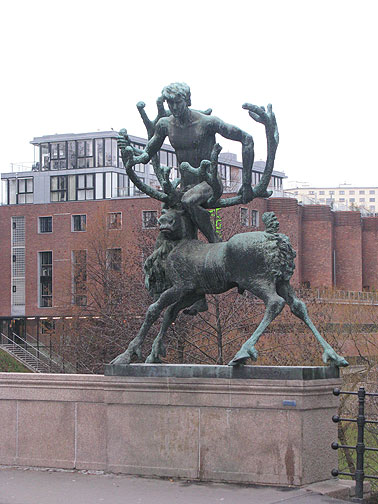
This Per Gynt reindeer sculpture is on the bridge crossing the Aker river in central Oslo.
Interestingly, the next day we went to the home of some of the folks who had come to the event. They live in a house they squatted several years ago, then moved out for two years while they pressured the city to give it to them, finally moving back in prior to an agreement that they can stay and rent it for a fraction of prevailing rents. They are busily turning it into an ecological model home, though it’ll be some years before they get there. Already they are putting hemp insulation into the basement, and preparing to build a chicken coop as well as various other home improvement projects. With the cold dark winter upon them, it looked like a lot of work will be delayed until next year, but there’s a solid group living there already, full of ideas and plans. It was a Nowtopian-style household, without a doubt!
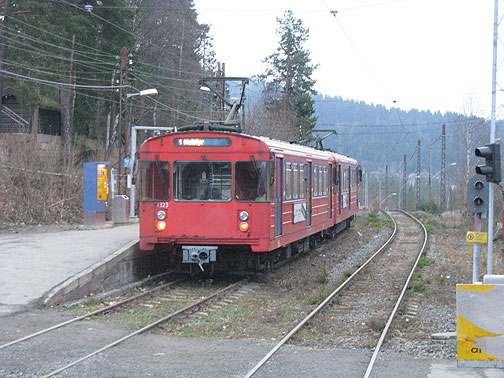
This was our old subway at the end of the line.
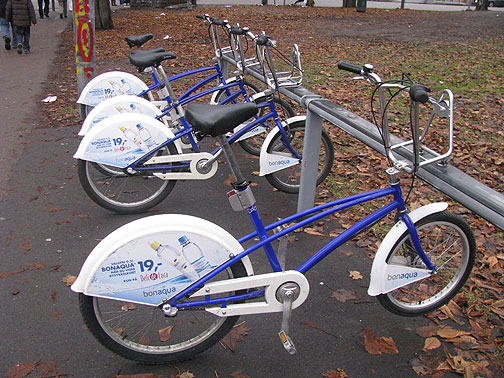
Like many cities now, Oslo has a public bike program, and we saw a lot of them whizzing around town while we were here, even though they're taking most of the fleet in for the winter.
Before we went there, Audun took us on a long subway ride up hill where we enjoyed some spectacular views, albeit under gray skies. Oslo sits on a big sprawling bay, and has a small pretty river running down the middle.
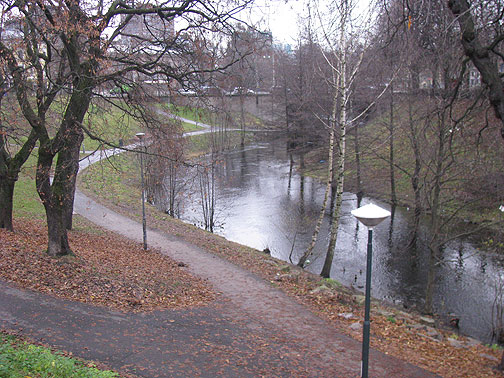
The Aker River in central Oslo.
The city is curiously divided between east and west, with the wealthier locals living on the west side in old elegant apartment buildings, streetside storefronts full of fancy boutiques and upscale shopping.
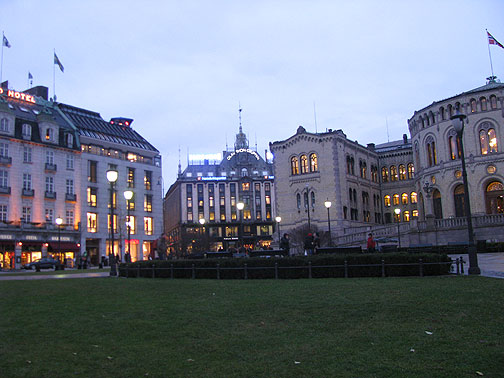
The old hotels at the center of the city, at 3:30 in the afternoon as dusk is settling.
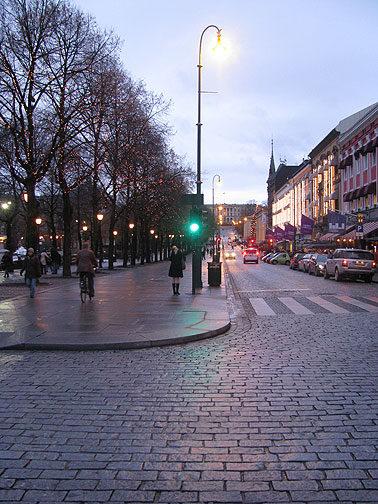
City center at dusk.
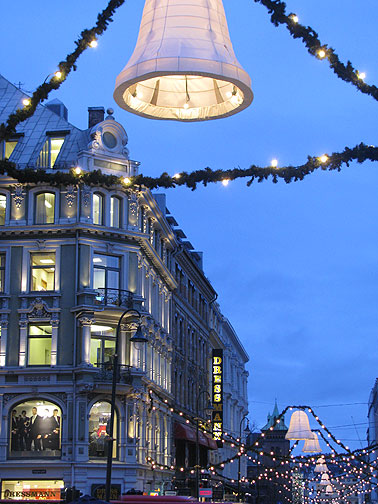
Xmas is in full swing here, with decorations over the shopping district, and in countless windows.
On the east side by contrast the architecture is made up of large apartment blocks, nicer than the worst ones seen in some places, but still pretty impersonal. The population is noticeably less wealthy than their west-side counterparts, and the immigrant population is entirely focused in certain parts of the east side too. (There are sizeable numbers of Turks, Pakistanis, and various other refugees in Oslo. The population of Norway is about 4.5 million, only 2/3 of the Bay Area’s!)
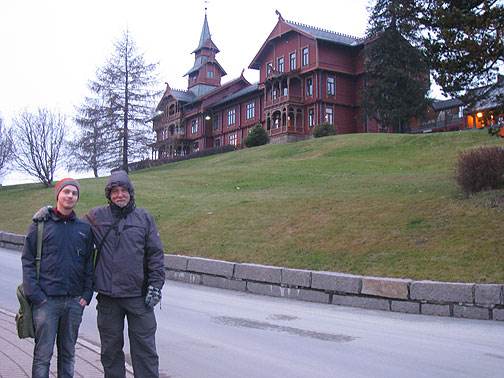
Here I am with Audun beneath an 1881 Hotel, a lovely example of Norwegian romanticism, combining rural Norway with Gilded Era ostentation and a dash of Viking thrown in...
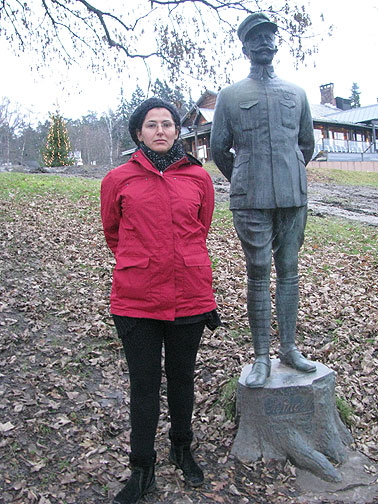
Oslo loves it statues; here is Adriana mimicking a miltary hero overlooking the city.
Audun also took us to see what he considered an essential showplace for Norwegian culture: Oslo’s City Hall. It’s a 1950s big brick building swathed in friezes and surrounded by sculptures highlighting in equal parts workers and mythical characters of Norway’s past. (One could argue I suppose that the workers as presented in the sculptures and murals inside are somewhat mythical too!) Norway is a Scandinavian social-welfare state par excellence. They have had the advantage of big North Sea oil reserves in their coastal waters, so for some time the country has been buoyed by oil money, helping to avoid the kind of retrenchment and austerity that a lot of other countries have had to endure lately. Still, the aura of neoliberalism shows up here in small ways (and larger ones too, I’m sure, but I’m less aware of them). Somehow Norway is the last place I’d expect all public bathrooms to charge for use, but so it is (apparently they do this to avoid junkies, of which there are a good number in the central city, using bathrooms as shooting galleries). And at the awful exchange rate, the 10 kroner comes out to about $1.85 per visit! The bus costs 25 kroner a ride (apx. $4.50 a ride) or 65 for day pass (about $11.50). Both our take-out Thai meal last night and our coffee and scone breakfasts cost around 200 kroner for two of us, so about $37! Very expensive to be here!…
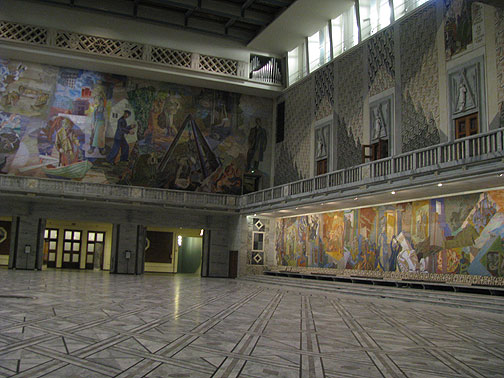
The main room in the sprawling 1950s City Hall, a monument to Norwegian Social Democracy.
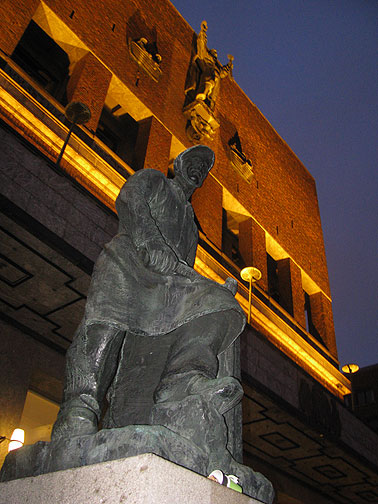
Bricklayer gazes out with determination while a Norse god celebrates on upper facade...
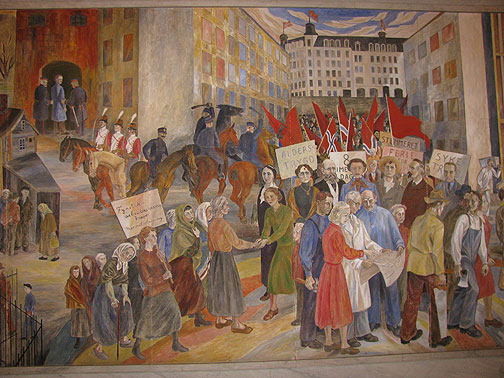
Left side of a mural inside City Hall depicting the Norwegian workers getting basic rights.
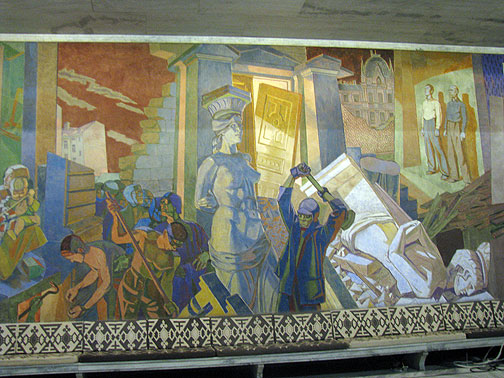
More scenes of victorious social democracy, this in mosaic in big hall.
Anyway, today we went across town in cold intermittent rain/snow to see Vigeland Park, a sculpture park that we’d heard about from many people. I looked at some photos online before we went, and I was worried that I’d find it completely kitschy and awful, but actually, I liked it very much! The human figures that cluster along the bridge and adorn the elevated obelisk plaza are super realistic, mostly nude, and all in various stages of wrestling, cuddling, hugging, etc. Taken one by one as you walk along, it’s amazing how many different emotions are evoked. In general, the sculptor Vigeland did an incredible job of portraying empathic characters, often in vulnerable and revealing poses. Here’s a gallery of images that we took.
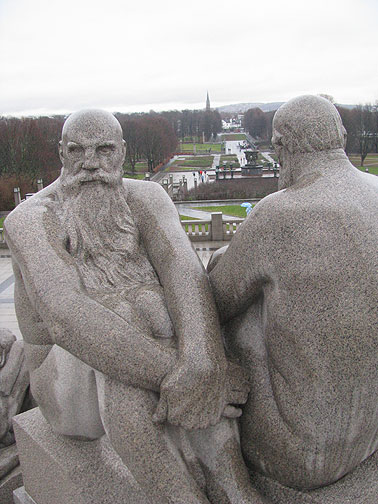
This sculpture and all that follow are in the Vigeland Sculpture Park, built in the 1920s-1930s, and filled with sculptures by Gustav Vigeland, a prolific Norwegian artist.
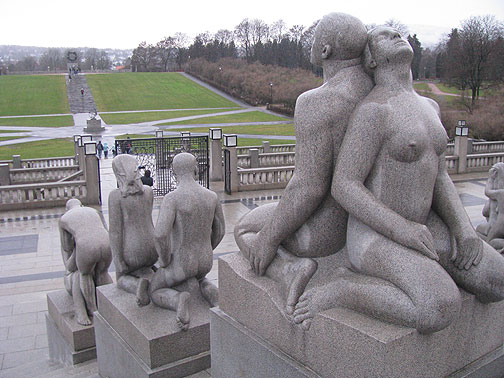
I was worried that I'd find the park really kitschy, but actually the characters are quite moving, often very vulnerable and empathatic.
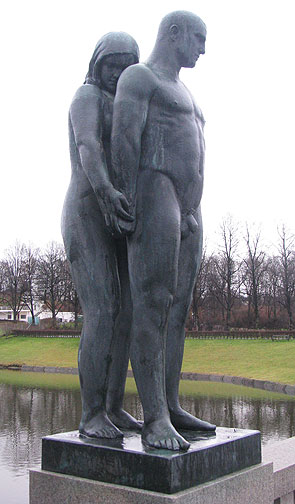
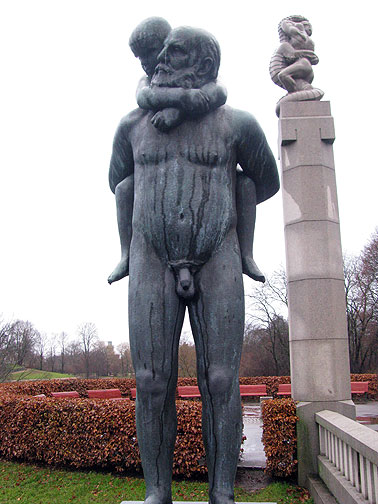
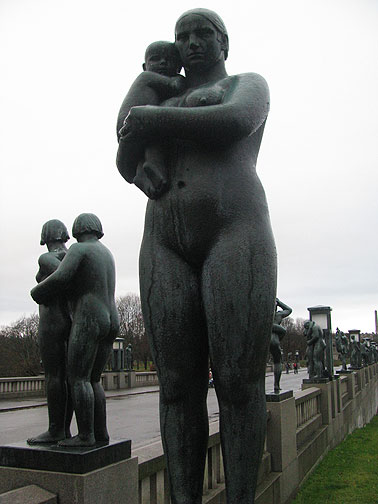

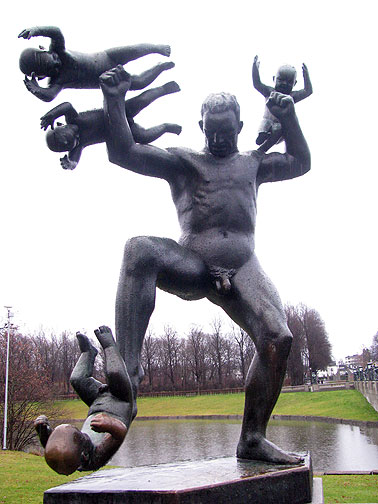
A lot of the sculptures are quite energetic, and some, like this one, are completely strange.
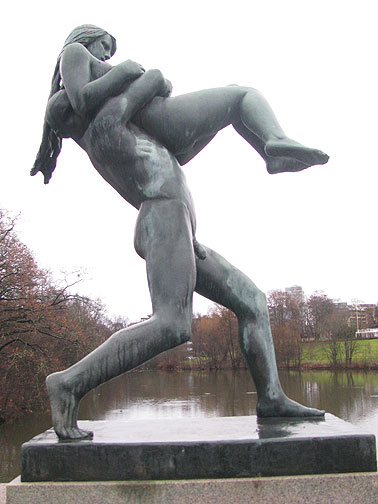
A half dozen or so depict a man and woman in the throes of serious wrestling, while others seem more like an early type of contact improvisational dance.
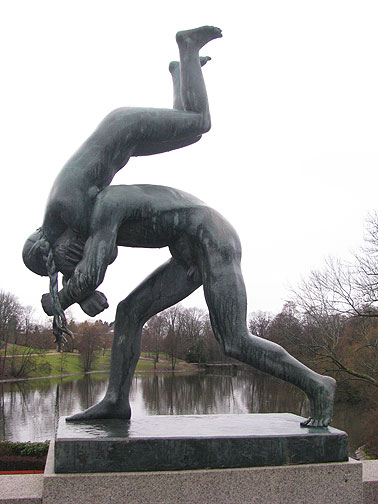
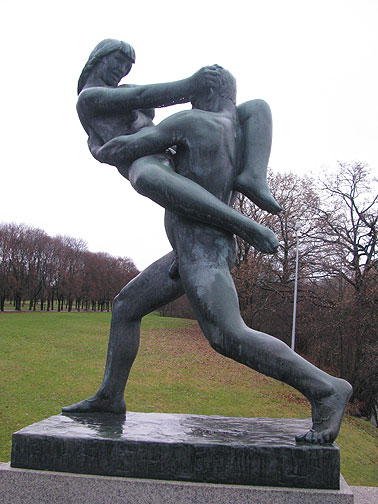
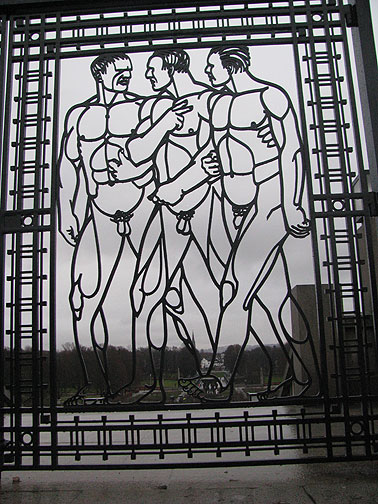
There are also these remarkable wrought iron gates.
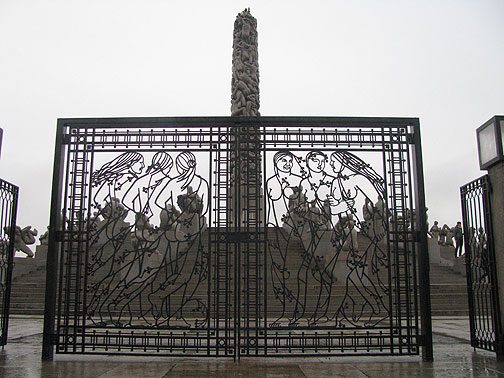
One side has men in the gate, the other has women.
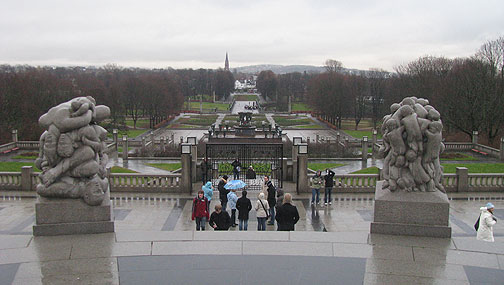
This is the view from the obelisk back across the park promenade.
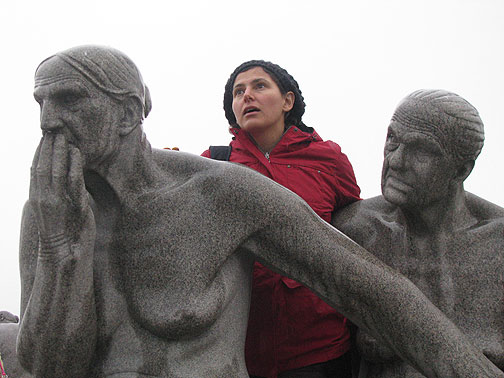
We couldn't resist, as it seems most visitors cannot, getting into the act with these intense characters.
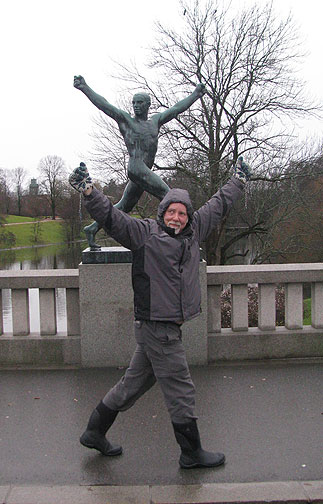 Next stop: Stockholm!
Next stop: Stockholm!












Leave a Reply